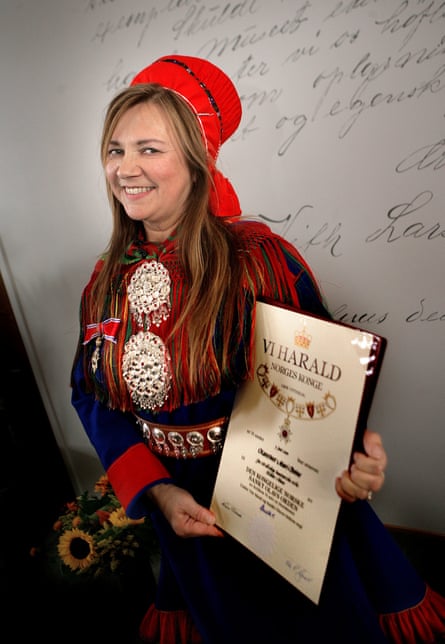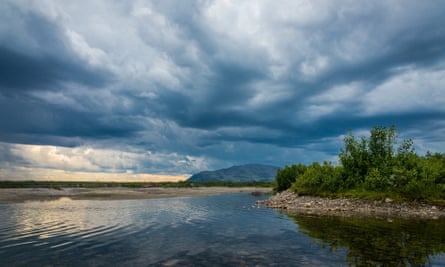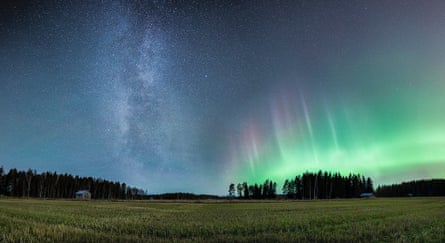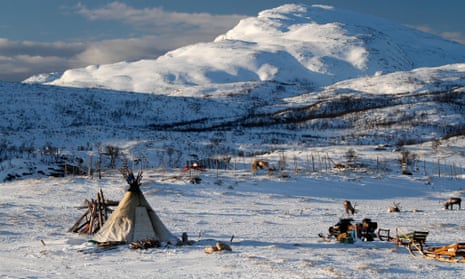The term Lapland is a word foreigners gave this area. We call it Sámiland, as it’s the huge area (the north of Norway, Finland, Sweden and Russia) that belonged to the Sámis. The Norwegian part, the northernmost county Finnmark, is as big as Denmark. I grew up there, close to the Finnish border. We had relatives living on the other side; the border meant nothing to us.
My home now is in beautiful Porsanger, in Sámiland. I’ve lived here for 30 years and I would recommend the area to tourists. It’s very spacious, wild and you can see far, far away. The further north you go, the more magnificent the view. Further south, everything is private, and you can’t really go to certain places, but here it’s still free. You can walk and just be in nature.
If you only come here for a short while, you will not see anything. You need to spend time. There are few restaurants or things that you’d find in the city, but you will have a special experience. Nature here is so wild, it forces you to meet yourself as there’s nothing to hide behind; you meet your own vulnerability, but also your grandness.

In summer, I love fishing and where I live there are a lot of salmon rivers. I have a view from my house of one of them, Stabburselva, coming down into the fjord. In many areas, to buy a card for fishing is very expensive, but here it’s not too bad and you can catch salmon weighing up to 20kg. The biggest I’ve caught is 2kg. There are some beautiful boat trips along the river, and it’s also wonderful for hiking, and an important area for migrating birds. They come all the way from South Africa. There’s a nature centre and viewpoint for watching them. As a child, I was fascinated by the arctic tern, which nests here then spends three months flying to South Africa. I also love fishing at Anarjohka, my childhood river.
This time of year is really for rough ones, tough people. It can get very cold. There’s not a lot to do in winter time but it’s magical. I love it. I live next to Stabbursdalen national park, a 130-mile drive from Ivalo (in Finland), where you fly to. There’s a resort with wooden cottages to rent, and you can go for walks, ski, go snowmobiling and watch the aurora borealis.
I’ve been seeing the aurora all my life. When we grew up, the Sámi told us we should not point at them because they are the dancing souls of those who have passed away. There are a lot of stories connected to them. It sometimes looks like a hand painting on the sky. I am very inspired by the whole of nature here. Sometimes I go out and it’s like there are songs hanging in the trees or the sky, or they come with the wind.
In January, there is a fantastic Sámi film festival in Inari, 25 miles from Ivalo, called Skabmagovat, which means the special time when the sun leaves us for two months, and there is just blue light. Films from the Sámi and other indigenous communities from around the world are shown in a theatre made from snow. Also in Inari is a shop called Samekki, selling Sámi handicrafts in silver, wood and leather, made by my friend Petteri Laiti.

There is a lot of beauty in our culture and it is very, very ancient. We have similarities to Native Americans and Inuits: for example we have tipis, called laavus, and tourists should try sleeping in one. I have one with a fireplace in my garden. Now it’s too cold to sleep out all night, but for New Year’s Eve I’m having lots of people over, and we will sit around the fire, talk, sing, drink beer – I will have a lot of artists and neighbours to visit.
Christianity really wiped out our traditions and rituals. But we still celebrate the time when the sun returns and, at Easter, we go to a place called Kautokeino where they have a very special festival. (sámieasterfestival.com). This was the time the reindeer herders came down from the mountains, socialised, and baptised the children. It’s a festival in that spirit. You can see traditional weddings and people wear colourful clothes. Couples walk in procession, and there’s reindeer racing and concerts. And we have this ancient singing, the yoik. The yoik is pentatonic, it can sound very monotonous, it doesn’t have a lot of words. It’s the way you sing just a few words that tells the story. We say that with a yoik, we don’t sing about a person, we sing the person. We go inside the feeling, we are the feeling when we sing, we don’t describe. That’s the difference between western and indigenous culture. I make modern music inspired by this, and take this philosophy with me. The yoik was also part of the shamanistic rituals. Every child that was born got a yoik, as well as a name. It was a way of remembering the person. They also had yoiks for nature. When the words are limited, it helps you express something. It’s for overwhelming feelings. My parents were Christian, they banned this devilish music, I didn’t grow up with it, I was told it was from the devil. But when I started singing I really rebelled. I started searching and found that I had a beautiful heritage.

The Santa Claus thing is something that the Finns made up for tourism. They have been very clever!. People need dreams, but that should go hand in hand with information about the people and the culture that is really here. I don’t like the way the Finns have done fake Sámi tourism. They dress up in fake Sámi clothes and colour themselves with coal to look like “dirty” Sámis. Travellers should do research and find smaller travel companies that are authentic. I want people to experience this beautiful area and learn about us, as long as we are not just decoration, and they come with respect, not just to consume. I am prouder of the northern lights tourism, it’s something real and more magical.
My favourite places to go out in Tromsø are Arctandria, a very good fish restaurant, and Raketten, Norway’s smallest bar, which a friend opened this year in a renovated old kiosk. He serves beer from the local Mack brewery, and sausages made from reindeer and elk. In July, there’s a wonderful festival close to Tromsø, called Riddu Riddu, which means “a little storm by the coast” – it was set up by people from the Sea Sámi community, which was really, really oppressed. It’s now 20 years old and they invite indigenous people from all over the world, which has been very important for Sámis to see. When we compare ourselves to Norwegians, we feel very different, but when we compare ourselves to other indigenous people around the world, we don’t feel so alienated. There are not many hotels, but there is a campsite, and many people stay in laavus there.
Sámi people today live in modern houses, fewer people are working in reindeer herding. And there’s a real a fight on because there are so many companies who have found minerals here, there’s a danger they will want to mine the land.
Sámis have a lot of worries that we would have to give up our ancient culture and reindeer herding, and that would be a big loss, for everybody. Because this is an ancient ancient culture with a lot of wisdom.
For information on Mari Boine’s music, visit mariboine.no

Comments (…)
Sign in or create your Guardian account to join the discussion